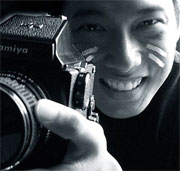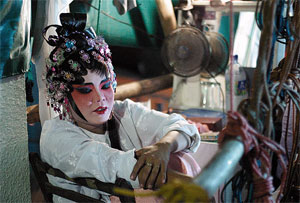 |
→ September 2005 Contents → Feature
|
Wail of the Wayang
|
 |
|||||||||
|
In the dim glow of a solitary light bulb, I watch Yap Chor Kiang slowly change from an ordinary woman into a legend. Sitting on a wooden stool with her hair pulled back, she studies her features in a small mirror. Nearby, an array of palettes and colored bottles lie on a paint-splattered table. With a brush and the practiced efficiency of a craftsman she begins the process: a coat of white is rubbed on her face, followed by a mask of crimson on the forehead, a tint of red on the lips and cheeks, and a daub of black over her eyelids. This exotic form of self-adornment goes on for an hour before the actor puts on the rest of her costume: a brilliant headdress of gilded sequins and wire, and a yellow silk gown, resplendent in the delicate patterns of old China. An assistant ties a sash around her waist and the transformation is complete. Yap Chor Kiang is no longer herself - tonight she is Xuan Zhong, empress of China.
One way or another we've seen their painted faces before - on postcards, magazines, TV specials or tourist brochures. Chinese opera is one of the most ancient forms of theatre in the world, its practice dating back to almost a thousand years in China. Although its exact origins are rather obscure, its artistic and cultural influences are believed to be even older, perhaps harking to the Xia Dynasty period some 4,000 years ago, when slaves were forced to sing and dance for their masters. Here in Singapore it made its first appearance in the mid-1800s, thanks to the thousands of Chinese immigrants who arrived on these shores.
Not surprisingly, this oriental opera became popular throughout the then-British colony, attracting huge crowds wherever a performance was organized. Theatre artists were regarded as celebrities, their names advertised in brightly-colored banners as come-ons to throngs of adoring fans. So ingrained in the local culture was Chinese opera that it became synonymous with entertainment - the word "wayang," in fact, means "show" in the native Malay language, a compliment to its proud status as the king of the performing arts.
Back at the stage, the performance is just about to begin. Chor Kiang steals a glance through the curtains at the audience waiting outside. I notice a slight frown on her painted lips.
"Few people as usual," she quips. "These days it's only the old ones who are interested in watching Chinese opera."
The play begins in an earsplitting clash of cymbals, pipes and strings. I go out front to see the spectacle unfold, careful not to sit on the empty front-row seats - these, I am told, are reserved for the roaming spirits. One by one the characters appear, dressed in their elaborate gowns and makeup, bellowing their dialogues in strong, stylized voices. Occasionally the lines would turn into songs, accompanied by the shrill notes of traditional instruments.
To a Filipino like me who has had little contact with Chinese performances, it is a heady dose of sights and sounds. While my ears are ringing from the auditory pounding, my eyes are feasting on the gorgeous tableau of colors and costumes. True to the needs of theatre, these visual cues are used to clearly define the characters on stage. A full white face, for example, denotes an evil or treacherous personality, while a red face suggests courage and righteousness in a protagonist. Yellow gowns, on the other hand, are reserved for royalty, while green costumes are only for the virtuous characters. Despite my being unable to understand the language (Chinese opera in Singapore is often performed in the Hokkien, Teochew and Cantonese dialects), I am drawn to the subtlety of the actors' movements; how their eyes roll with their facial expressions, and at the way their bodies move with studied elegance. Each wave of the hand and tilt of the head, it seems, adds to the richness of the dialogue.
Two hours later I witness the final act. Guided by the cymbals and the gongs, the main characters engage in a climactic battle. I watch their fluid motions of equal parts kung-fu and dance, their swords and staffs flaring in the floodlights. The action is quick and graceful, and oddly reminiscent of those Hong Kong martial arts films. Perhaps in more ways than one, Chinese opera is still present in popular entertainment.
"Our troupe might close down in a few years," she reveals. "The owner is getting old and nobody wants to take over his job."
Unlike before there is little money in this business, she admits, and it is only her love for Chinese opera that has kept her here for the last 15 years. Whereas kids in Singapore once aspired to be wayangs, today their art is in danger of dying out.
I ask the actress what happens next if the Golden Eagle Troupe does close down. She shrugs and looks away, tears welling in her eyes.
"I try not to think about it," Chor Kiang admits. "I don't know what happens next."
© Lester V. Ledesma
Skylight Images
|
||||||||||
Back to September 2005 Contents
|
|


